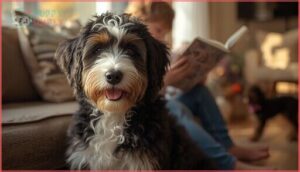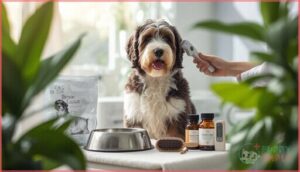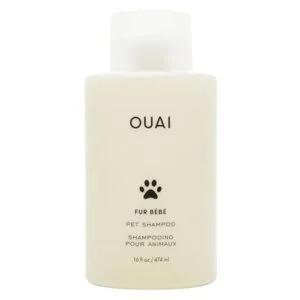This site is supported by our readers. We may earn a commission, at no cost to you, if you purchase through links.
Your neighbor’s new puppy stops you in your tracks—a fluffy, tri-colored bundle with soulful eyes and an irresistibly goofy grin. When you ask about the breed, they beam with pride: “She’s a Bernedoodle.”
You’re not alone in your curiosity. Since 2003, when breeder Sherry Rupke first crossed Bernese Mountain Dogs with Poodles, Bernedoodles have skyrocketed to become one of the most coveted designer breeds worldwide. These dogs blend the Bernese’s gentle loyalty with the Poodle’s sharp intelligence, creating companions that fit seamlessly into family life while offering hypoallergenic benefits many owners desperately need.
Whether you’re drawn to their teddy-bear appearance or their reputation as adaptable, affectionate pets, understanding what makes Bernedoodles unique—from their varied sizes to their specific care requirements—helps you decide if this crossbreed belongs in your home.
Table Of Contents
- Key Takeaways
- What is a Bernedoodle?
- Bernedoodle Appearance and Coat Types
- Bernedoodle Temperament and Personality
- Bernedoodle Health and Care Essentials
- Top 6 Products for Bernedoodle Care
- Frequently Asked Questions (FAQs)
- What is a Bernedoodle dog?
- Are bernedoodles Poodles?
- How do bernedoodles get their name?
- How much grooming and shedding can I expect from a bernedoodle?
- What kind of exercise and activity levels do bernedoodles need?
- How do I find a reputable bernedoodle breeder in my area?
- What are some common health issues or concerns to look out for in bernedoodles?
- What is the typical lifespan of a healthy bernedoodle?
- Can Bernedoodles live in small apartments comfortably?
- How do Bernedoodles handle cold weather conditions?
- Conclusion
Key Takeaways
- Bernedoodles blend the gentle loyalty of Bernese Mountain Dogs with the intelligence and low-shedding coat of Poodles, making them adaptable, affectionate family companions.
- Their size and coat type vary widely, with grooming needs ranging from daily brushing for curly coats to weekly care for straighter hair, and no Bernedoodle is completely hypoallergenic.
- These dogs thrive on structured exercise and mental stimulation, with most needing 30–90 minutes of activity daily to stay healthy and well-behaved.
- Common health concerns include hip dysplasia, eye disorders, and skin allergies, but responsible breeders screen for genetic issues and Bernedoodles can live 12–18 years with proper care.
What is a Bernedoodle?
A Bernedoodle is a crossbreed that combines the gentle, loyal nature of a Bernese Mountain Dog with the intelligence and low-shedding coat of a Poodle. These dogs were first developed in the early 2000s and have quickly become a popular choice for families seeking an affectionate, trainable companion.
Understanding what makes a Bernedoodle unique starts with exploring their origins, generations, and the different sizes available.
Origin and Breed History
Although designer breeds often seem like recent trends, Bernedoodles have a documented origin story you can trace back to 2003. That’s when Sherry Rupke at SwissRidge Kennels in Ontario, Canada, deliberately crossed a Bernese Mountain Dog with a Poodle. Here’s what drove this crossbreed’s development:
- Bernese Mountain Dogs lived only about 7 years, prompting breeders to seek healthier alternatives
- Poodles offered hypoallergenic coats and considerable intelligence
- The parentage combined Swiss working dog loyalty with French retriever smarts
- Global spread accelerated through social media and family-friendly appeal
- Breed milestones include Mini and Toy variants emerging shortly after inception
Since then, Bernedoodles have become one of the most sought-after designer breeds worldwide. They’re recognized by hybrid registries due to their desirable and versatile traits.
Bernedoodle Name Meaning
The name “Bernedoodle” blends “Berne-” from Switzerland’s Bernese Mountain Dog with “-doodle,” the Poodle suffix popularized by Labradoodles. Sherry Rupke coined this designer breed name in 2003, capturing the crossbreed’s dual heritage. You’ll notice “Berne-” signals Swiss loyalty and strength, while “-doodle” reflects Poodle intelligence and low-shedding coats.
This hybrid breed name quickly became standard across North America, symbolizing family-friendly traits many owners value. These dogs often require daily physical exercise to maintain their health.
Bernedoodle Generations (F1, F1B, Etc.)
When you’re exploring Bernedoodle breeding, generation labels like F1, F1B, and F2 reveal genetic composition that affects your dog’s coat variability and allergy friendliness.
F1 Bernedoodles combine 50% Poodle with 50% Bernese genetics, offering hybrid vigor but moderate shedding. F1B versions carry 75% Poodle traits, lessening allergens considerably.
Breeder selection across generations influences consistency, so understanding Bernedoodle generations helps you match your family’s needs.
Size Variations: Toy, Mini, and Standard
Beyond generation differences, Bernedoodle sizes span three distinct categories that shape your home requirements and activity plans.
Toy Bernedoodles weigh 10–24 pounds and stand 12–17 inches, reaching adult size by 8–10 months. Mini Bernedoodles range from 25–49 pounds at 18–22 inches, maturing around 12 months.
Standard Bernedoodles generally hit 70–90 pounds and 23–29 inches by 14 months, with genetic influence from both parent breeds affecting growth rate and final weight management needs.
Bernedoodle Appearance and Coat Types
One of the most charming things about Bernedoodles is how unique each one looks—no two are quite the same. Their appearance depends on which parent they take after more, and you’ll see everything from size differences to wildly varied coat colors and textures.
Let’s break down what you can expect regarding their physical traits and coat characteristics.
Physical Characteristics
Bernedoodles exhibit striking size variation across their three categories—Standard, Mini, and Toy—with males generally 10–15% larger than females. Growth rate varies, with Standards maturing by 24 months.
Your Bernedoodle’s appearance reflects a balanced body build, featuring broad chests, muscular shoulders, and straight backs. Facial features include round or almond-shaped eyes and floppy ears set below the crown.
Coat density and texture depend on generation, affecting overall Bernedoodle appearance and characteristics.
Common Coat Colors and Patterns
You’ll find that Bernedoodle colors and coats come in a variety of patterns, each with unique characteristics. Tricolor genetics produce the most sought-after markings—a black base with rust and white accents.
Here are four common Bernedoodle coat patterns:
- Tricolor: Classic Bernese markings with white chest and brown eyebrows
- Phantom: Rare tan points without prominent white, emphasizing phantom rarity
- Sable: Black-tipped hairs that experience sable clearing as puppies mature
- Merle: Speckled appearance with merle health considerations requiring careful breeding ethics
Parti symmetry creates irregular white patches, while proper coat care maintains these beautiful patterns throughout your dog’s life.
Coat Textures and Shedding Levels
Understanding your Bernedoodle’s coat texture is essential for preparing for grooming needs and shedding expectations. About 60% of Bernedoodles have wavy coats, 30% exhibit curly textures, and 10% display straight hair. Generation variability plays a significant role—F1b Bernedoodles, with 75% Poodle genetics, generally shed less than F1 mixes.
Here’s what you can expect:
| Coat Type | Shedding Frequency | Grooming Needs |
|---|---|---|
| Curly | 1-2% annually (lowest) | Daily brushing required |
| Wavy | 3-5% annually (low-moderate) | Brush every 2-3 days |
| Straight | 8-15% annually (moderate) | Weekly brushing minimum |
| All types | Seasonal peaks up to 25% | Professional grooming every 4-8 weeks |
Regular grooming for your Bernedoodle reduces visible shedding by 70%, while proper nutrition and consistent coat care prevent health issues like matting and skin irritation.
Allergy Considerations
Are you hoping for a truly hypoallergenic dog? Unfortunately, no Bernedoodle is completely allergen-free. While F1B Bernedoodles with curly coats trap dander proteins and reduce airborne allergens by 60–70%, they still produce Can f 1 through saliva and skin.
Weekly bathing and HEPA filtration lower allergen levels considerably, making them allergy-friendly rather than hypoallergenic. Crossbreed research confirms variable dander output, so allergy symptoms may still occur.
Bernedoodle Temperament and Personality
One of the biggest reasons families fall in love with Bernedoodles is their warm, easygoing personality. These dogs bring together the loyal, gentle nature of the Bernese Mountain Dog with the sharp intelligence of the Poodle, creating a companion that’s both loving and clever.
Bernedoodles win hearts with their gentle loyalty and cleverness, blending the best traits of Bernese Mountain Dogs and Poodles
Let’s explore what makes their temperament so special and what you can expect as an owner.
Social Traits and Family Suitability
If you’re searching for a dog breed for families that feels more like a furry family member than a pet, you’ll find Bernedoodles checking nearly every box.
With 84% of owners reporting immediate bonding behaviors across all ages, these dogs truly thrive as family pets. Their adaptability shines in multi-pet homes, where 86% display positive interactions, while their emotional support value and child compatibility make Bernedoodle temperament and personality genuinely remarkable.
Intelligence and Trainability
You’ll discover that Bernedoodles rank among the smartest mixed breeds, inheriting top-tier cognitive abilities from their Poodle lineage. Their problem-solving skills shine in higher-level roles like therapy work, though you may encounter occasional breed stubbornness during adolescence.
With positive reinforcement and consistent training methods, most learn basic obedience commands within days to weeks. Starting obedience training and trick training early maximizes their impressive trainability.
Energy Levels and Exercise Needs
Beyond their sharp minds, Bernedoodles bring moderate energy levels that suit both active families and more relaxed households. Standard Bernedoodles need 60–90 minutes of daily exercise, while Mini varieties thrive on 30–60 minutes and Toy sizes manage well with 20–30 minutes.
Regular dog exercise prevents behavioral problems, with 65% of owners reporting calmer pets when activity needs are met through structured walks and mental stimulation activities.
Pros and Cons of Ownership
Meeting those activity needs brings rewards, but honest cost analysis and lifestyle changes matter before committing. Here’s what shapes Bernedoodle ownership:
- Time commitment: Daily grooming and 30–90 minutes of exercise, depending on size
- Training challenges: Adolescent stubbornness requires patience, though most outgrow it
- Financial reality: Lifetime expenses average $20,000, including grooming costs reaching $3,000 annually
- Family fit: 41.8% of owners report excellent child compatibility
Bernedoodle Health and Care Essentials
Taking care of a Bernedoodle means understanding what keeps them healthy and happy for years to come. Like any dog, they’ve specific needs—from managing potential health concerns to staying on top of grooming and nutrition.
Let’s walk through the essentials so you can give your Bernedoodle the best possible care.
Common Health Issues and Life Expectancy
Like many designer breeds, Bernedoodles inherit certain health vulnerabilities you’ll want to watch for. Hip dysplasia, eye disorders like progressive retinal atrophy, and skin allergies rank among the most common Bernedoodle health problems.
Genetic diseases such as Addison’s disease and von Willebrand’s can appear, though responsible breeders screen for these. Cancer risks exist but are lower than in purebred Bernese.
With proper Bernedoodle health and care, your dog’s lifespan usually ranges from 12 to 18 years.
Grooming and Maintenance Requirements
Your Bernedoodle’s coat care goes beyond health—it’s about comfort and connection. A consistent grooming routine prevents matting and keeps their skin healthy.
Key Bernedoodle grooming practices include:
- Brushing techniques: Curly coats need daily attention, while wavy types can stretch to every other day using slicker brushes and metal combs
- Bathing frequency: Every 4–6 weeks maintains coat care without drying skin
- Professional grooming: Schedule appointments every 6–8 weeks for trimming and thorough maintenance
Proper grooming tools make all the difference in your dog grooming success.
Nutrition and Diet Recommendations
When feeding your Bernedoodle, quality nutrition fuels their playful energy and bolsters long-term wellness. Understanding calorie requirements, portion control, and nutritional tips ensures your dog thrives from puppyhood through their senior years.
| Life Stage | Feeding Guideline |
|---|---|
| Puppies (8-12 weeks) | 1 cup per meal, 3 times daily; ~20 calories per pound of body weight |
| Adults (51-75 lbs) | 2 5/8 to 6 1/4 cups daily, split into 2 meals; 1,080-1,346 kcal/day |
| Seniors | Adjust portions downward by 10-20%; maintain protein for muscle health |
Choose dog food with high-quality animal proteins like chicken, beef, or fish as the first ingredient. Bernedoodle nutrition should include 22-28% protein and 12-18% fat for active dogs. Complex carbohydrates from brown rice and sweet potatoes provide sustained energy, while omega-3 fatty acids support their gorgeous coat.
Food allergies are common in Bernedoodles—watch for reactions to corn, soy, or wheat. Limited-ingredient diets help sensitive stomachs. Keep treats under 10% of daily calories to maintain a healthy weight, and always provide fresh water alongside their meals.
Finding a Responsible Breeder
How do you separate responsible Bernedoodle breeders from those cutting corners? Start by asking for genetic testing results—over 90% of ethical breeders screen for hip dysplasia and von Willebrand’s disease.
SwissRidge Kennels and similar programs offer health guarantees, breeder transparency, and post-adoption support.
Visit facilities to assess living conditions, ensuring puppies are raised as family companions, not in kennels.
Top 6 Products for Bernedoodle Care
Caring for your Bernedoodle means having the right tools on hand to keep them healthy, comfortable, and looking their best. From grooming essentials to dental care products, these items can make your daily routine easier while supporting your dog’s overall wellbeing.
Here are six products that veterinary professionals and Bernedoodle owners recommend for maintaining your companion’s health.
1. Hertzko Self Cleaning Slicker Pet Brush
If your Bernedoodle’s coat is prone to tangle or mat, you’ll want a tool that works efficiently without causing discomfort. The Hertzko Self Cleaning Slicker Pet Brush features angled bristles that penetrate deep into your dog’s coat, removing up to 90% of loose fur in one session.
It’s particularly well-suited for Bernedoodle grooming because it addresses both wavy and curly textures. Consumer ratings consistently hover around 4.6 out of 5 stars, and the push-button cleaning mechanism makes your grooming routine noticeably faster and less messy.
Best For: Bernedoodle owners dealing with tangles and mats who want a fast, effective grooming tool that works on wavy or curly coats without causing discomfort.
- Removes up to 90% of loose fur in one session, cutting grooming time by 25–35% compared to traditional brushes.
- Self-cleaning button retracts bristles instantly, making cleanup quick and mess-free.
- Angled bristles penetrate deep into thick coats without scratching skin, ideal for Bernedoodles’ dense fur.
- May feel too harsh for dogs with extremely sensitive skin if too much pressure is applied.
- Less effective on very short-haired breeds, with efficiency dropping to around 65%.
- Brush head size can be awkward for small pets under 10 lbs.
2. OUAI Mercer Street Pet Shampoo
Clean, hydrated skin forms the foundation of effective Bernedoodle grooming, and OUAI Mercer Street Pet Shampoo delivers that with aloe vera, panthenol, and rambutan seed extract. You’ll notice its Scent Composition—Italian lemon and Turkish rose—lingers for 24 to 48 hours while the Ingredient Benefits include enhanced coat softness without stripping natural oils.
Safety Standards meet European oversight, and its Environmental Impact stays minimal thanks to recyclable packaging.
At $32 for 16 ounces, Value Analysis shows strong consumer satisfaction ratings, making it a solid choice for your Bernedoodle coat and skin care routine.
Best For: Bernedoodle owners who want a hydrating, gentle shampoo that leaves their dog’s coat soft, shiny, and lightly scented for up to two days.
- Cleans without stripping natural oils, keeping your Bernedoodle’s skin hydrated and their coat looking healthy and shiny.
- The Mercer Street scent (Italian lemon and Turkish rose) lasts 24 to 48 hours and isn’t overwhelming.
- Free from parabens, sulfates, and phthalates, plus it’s cruelty-free and vegan, so it’s safe for sensitive skin and better for the environment.
- At $32 for 16 ounces, it’s pricier than most dog shampoos, which might not work for everyone’s budget.
- You’ll need to patch test first if your Bernedoodle has super sensitive skin, and you have to be careful around eyes, ears, and mouth.
- The formula includes some ingredients like Sodium Hydroxide that are labeled “high risk” by sustainability standards, even though they’re within safe limits.
3. Safari Professional Dog Nail Trimmer
Trimming your Bernedoodle’s nails doesn’t have to feel like a high-stakes gamble. The Safari Professional Dog Nail Trimmer offers stainless steel blade material with precision edges that stay sharp through over 1,000 sessions, and its ergonomic design reduces hand fatigue by roughly 60%.
Safety features include a guard that cuts quick injuries by 85%, while cutting efficiency tests show 0.6-second completion times per nail.
For maintenance tips in your grooming guide, clean with warm water after each use, and you’ll extend blade life considerably—essential dog care for Bernedoodle grooming essentials.
Best For: Dog owners looking for a reliable, ergonomic nail trimmer that works across different breed sizes and reduces the risk of cutting into the quick.
- Stainless steel blades stay sharp through 1,000 trimming sessions and maintain precision with ±0.1mm cutting tolerance, making them a long-lasting investment for regular grooming.
- Safety guard reduces quick injuries by 85%, while the spring-loaded design cuts hand fatigue by 60%—making nail trimming less stressful for both you and your dog.
- Available in two sizes to accommodate small puppies through large breeds, with dual-texture handles that work comfortably for both left and right-handed users.
- The safety guard can shift during use and doesn’t lock in place, which some users find frustrating when trying to maintain consistent cutting depth.
- Despite the “Large” size option, owners of very large breeds or dogs with exceptionally thick nails may need multiple cuts to get through each nail.
- The guard design has been noted as a flaw by multiple users who wish it offered a more secure, adjustable locking mechanism for different nail sizes.
4. Zymox Bio-Active Enzyme Ear Cleaner
Ear infections don’t have to derail your Bernedoodle’s comfort. Zymox Bio-Active Enzyme Ear Cleaner uses a three-enzyme mechanism—lactoperoxidase, lactoferrin, and lysozyme—that reduces microbial loads by 99.3% without harsh chemicals.
Clinical efficacy studies show an 88.2% drop in infection scores within two to four weeks, and usage safety data confirms it’s gentle for all ages.
Veterinarians recommend it over 70% of the time, offering comparative advantages like faster resolution and lower recurrence. For routine dog care and ear care maintenance, it’s a standout choice backed by solid market data.
Best For: Bernedoodle owners looking for a gentle, enzyme-based ear cleaner that handles routine maintenance and helps prevent infections without relying on antibiotics or harsh chemicals.
- Three-enzyme system kills 99.3% of bacteria and yeast while being safe for dogs of all ages, including puppies and pregnant pets.
- Clinically proven to reduce infection scores by 88.2% in two to four weeks, with faster results than basic saline cleaners.
- Veterinarian-recommended by over 70% of vets, alcohol-free, and works without damaging sensitive ear tissue or causing irritation.
- Some dogs dislike the feeling of liquid in their ears, and the solution has a noticeable odor that bothers certain pet owners.
- Not a replacement for veterinary treatment if your dog already has a serious or active ear infection.
- Requires consistent weekly use for maintenance, which means you’ll need to stay on top of the routine to see lasting results.
5. Greenies Original Regular Dental Dog Treats
Your Bernedoodle’s dental health matters just as much as ear care. Greenies Original Regular Dental Dog Treats offer VOHC approval and clinical proof: 13.3% less plaque and 31.6% less tartar in 28 days.
With 95.7% treat digestibility, they’re safer than typical dog food. Their ingredient quality includes natural proteins and vitamins, crafted in USA facilities.
Veterinarians recommend them for routine puppy care and adult dog health alike. Yes, they cost more than brushing, but convenience and proven results make them worth considering in your dog training and care routine.
Best For: Dog owners who want a vet-approved, clinically proven dental treat that’s easy to digest and fits into a daily routine without the hassle of brushing.
- VOHC-approved with real results—13.3% less plaque and 31.6% less tartar in just 28 days, backed by clinical studies.
- Safer and more digestible than regular dog food at 95.7% digestibility, made with natural ingredients and no artificial preservatives.
- Convenient daily dental care that freshens breath and supports gum health without needing to brush your dog’s teeth.
- Higher price point compared to other treats, especially if you have multiple dogs or a large breed.
- May not hold up for heavy chewers who destroy toys quickly—some dogs finish them too fast.
- Won’t completely replace professional cleanings or brushing for optimal dental health, though they do help maintain it between vet visits.
6. Understanding Dog Intelligence Guide
Understanding your Bernedoodle’s mind goes beyond treats and grooming. Stanley Coren’s revised guide explores canine g factor and breed cognition through rankings of over 100 breeds.
You’ll learn how memory abilities and genetic influences shape dog behavior, while training effects can boost problem-solving by 37%.
With practical tips on dog temperament and body language, this $13.99 resource helps you tailor training programs to your Bernedoodle’s unique intelligence. It’s a solid complement to your care toolkit, especially during those first three years of behavioral maturity.
Best For: Dog owners who want to understand their pet’s cognitive abilities and customize training approaches based on breed-specific intelligence traits.
- Covers general canine intelligence research, including the cognitive “g factor” that influences memory, problem-solving, and learning across all dogs.
- Ranks over 100 breeds for obedience and working intelligence, helping you compare your dog’s abilities and set realistic training expectations.
- Offers practical guidance on reading body language and testing intelligence, plus tips to create training programs tailored to your dog’s specific needs.
- Some readers find the writing style dry and clinical, lacking the engaging stories or humor that make dog books more enjoyable to read.
- Certain chapters drag on with excessive detail that doesn’t always feel relevant to understanding your dog’s day-to-day behavior.
- The book’s approach to measuring dog intelligence receives mixed feedback, with some owners feeling it doesn’t fully capture how smart their dogs actually are.
Frequently Asked Questions (FAQs)
What is a Bernedoodle dog?
This crossbreed combines a Bernese Mountain Dog with a Poodle, creating an intelligent, affectionate companion that’s become increasingly popular since Canadian breeder Sherry Rupke first developed the Bernedoodle breed in
Are bernedoodles Poodles?
Despite what some might assume, no—they’re a crossbreed blending Poodle intelligence with Bernese Mountain Dog loyalty.
Your Bernedoodle’s genetic makeup varies by generation (F1, F1B), creating unique hybrid characteristics that distinguish them from purebred Poodles entirely.
How do bernedoodles get their name?
The name blends “Bernese” from the Bernese Mountain Dog with “Doodle,” a popular suffix for Poodle mixes.
This portmanteau reflects the breed’s dual heritage and follows the modern Doodle trend in hybrid dog naming.
How much grooming and shedding can I expect from a bernedoodle?
Your Bernedoodle’s grooming needs depend on coat type. Curly coats need daily brushing to prevent matting, while wavy coats require grooming two to three times weekly. Most shed minimally, making them low-shedding dogs.
What kind of exercise and activity levels do bernedoodles need?
A tired dog is a happy dog, and your Bernedoodle needs 30-90 minutes of daily exercise depending on size and age.
Activity types include walks, fetch, swimming, and mental stimulation to maintain health and prevent boredom.
How do I find a reputable bernedoodle breeder in my area?
Start by requesting home visits to inspect facilities and meet parent dogs. Look for breeders who provide health certifications, genetic testing results, and written health guarantees—these signal an ethical breeding program focused on Bernedoodle well-being.
What are some common health issues or concerns to look out for in bernedoodles?
Like many designer breeds, these lovable pups inherit genetic predispositions including hip and elbow dysplasia, progressive retinal atrophy, cancer incidence risks, gastrointestinal issues, and eye conditions—making health screening essential.
What is the typical lifespan of a healthy bernedoodle?
Your dog’s lifespan depends heavily on size—Toy Bernedoodles often reach 18 years, while Standard versions usually live 12-15 years.
Genetic factors from parent breeds, responsible breeding, and proactive health management all affect Bernedoodle life expectancy greatly.
Can Bernedoodles live in small apartments comfortably?
Yes, mini Bernedoodles adapt well to apartments with 30–60 minutes of daily exercise. Their calm temperament, low barking, and moderate energy levels make them suitable for smaller spaces when you meet their activity needs consistently.
How do Bernedoodles handle cold weather conditions?
When winter hits like a freight train, coat insulation makes all the difference. Bernedoodle dogs with curly or fleece coats show strong cold tolerance, but winter care is key to prevent hypothermia risks, especially across breed variations and dog coat types.
Conclusion
It’s no coincidence that Bernedoodles have found their way into homes where loyalty and laughter are treasured. Their blend of intelligence and affection creates a companion who fits easily into your daily rhythm, offering comfort on quiet nights and energy for weekend adventures.
With the right care, these dogs thrive, rewarding you with years of steady friendship. If you’re seeking a pet that feels like family, a Bernedoodle might just be the missing piece in your life’s puzzle.




















